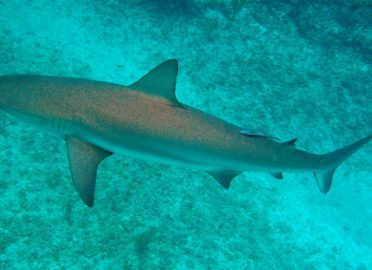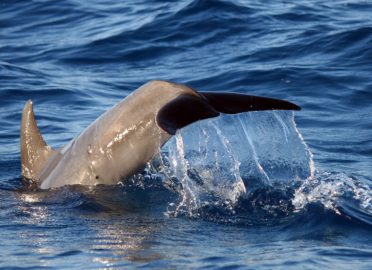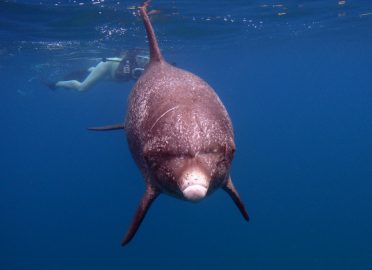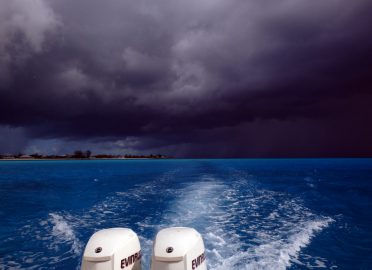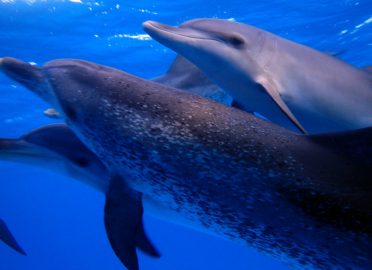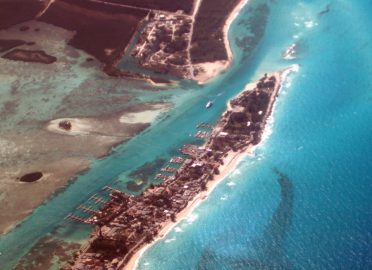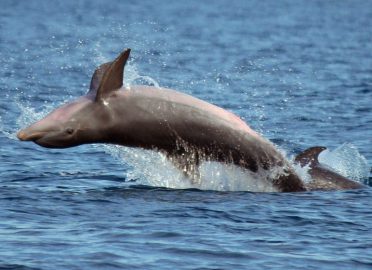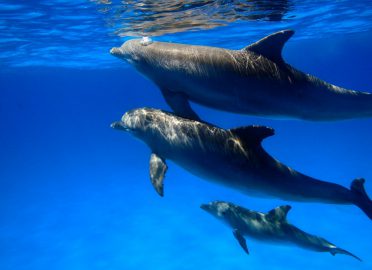Shaaaaaaaaarrrkks!!
Tuesday’s morning session included a discussion about contact and signal exchanges, and female association patterns, among Atlantic spotted dolphins on the Little Bahama Bank. The mother-calf relationship really stood out to us. It is interesting to learn that although the one mother/one calf bond is so strong, there are other relationships that help ensure the safety and wellbeing of the calf. It made sense to us that a mother’s foraging strategies might need to change as she works to meet the demands of her new calf. Alloparenting (or, babysitting) may help her succeed in making these changes.
It’s a bottlenose!! Or a dozen.
On Sunday our class session revolved around tool use, pectoral fin contact and group living. Included in our discussion was outlining the pros and cons (or benefits and costs) of group living. The ocean environment is a major factor influencing the benefits. We discussed “Understanding Dolphins” and began brainstorming topics for our final papers. We practiced using the terms discussed in class when we were on the boat later in the day!
We enjoyed our enchilada soup lunch and got ready for the boat.
The Lucky Charms
On Monday, breakfast was a little earlier so that we could get to South Bimini. Once there, we had a tour of the Bimini Sands’ Nature Trail. We were divided between a “sweet buggy” and a van with two “sunroofs.” We were followed by two friendly dogs – we can’t see an animal any more without trying to assess its behavior! We saw several lizard species including anoles. A brown racer (snake) was in the brush next to the path and we saw two termite mounds. When the mound was poked, we got to see some come out.
Womp Womp Womp
On Friday, after breakfast, we discussed last night’s movie, “Who Bought A Zoo.” The conversation specifically about the movie didn’t last long, but we were soon discussing the ethics surrounding decisions about zoos & aquariums.
Dolphins!
Saturday started off like other days (oh, poor us!) with breakfast, our field report and our discussion on last night’s movie, DOLPHINS. This led us to discussing the humans impacts facing dolphins: general pollution, including mercury, noise pollution, over fishing and more. People care about individual animals, but we need to think about conservation as a whole.
Spy Creature Adventures!
Thursday morning was fitness time for some of us, with yoga and exercises on the beach. Not a bad view for a workout! Then it was the routine of breakfast and class. We were visited by Skype by Dr. Dudzinski. Her lecture was on bioacoustics. We found her to be a good teacher, adding anecdotes to the physics of sounds. There was a lot of discussion on noise pollution and what the difference between sound and noise is.
Today was cool.
On Wednesday, we learned that we would not be able to go on our first boat trip because of wind. This was disappointing, but heck, we’re still in The Bahamas! In the morning, we discussed ecotourism; we probably could have talked about this all day! But, we know we’ll be experiencing the Bimini environment first hand, and reading about ecotourism, so we know we’ll have a larger discussion next week.
And so it begins…
On Monday, we were in full preparation mode. The island was slowly quieting, but our busy week was just beginning. On Tuesday afternoon we welcomed this year's Sacred Heart University (SHU) field course! Led by Dr. Deirdre Yeater, this year's group is a mix of SHU & Eckerd College students. We know it will be a fantastic program and we hope you enjoy all of the student-written field reports. The first one starts below! ~Kel & Nicole
We all met for the first time at the Fort Lauderdale Airport.
Bottlenose, spotted and mixed-species! Yippee!
On Friday morning, Kathleen and Kel met up with the film crew to finish with interviews and last-minute details. Around mid-day, Kel and Nicole bade farewell to Kathleen who headed back to the states. It was not a sad farewell, though, because we will be seeing her again in June!
We got a bit of a late start on the boat in the afternoon because of some camera trouble but we were able to set off a bit before 2 pm. After about an hour of searching, we came across a group of about 3 bottlenose dolphins.
Blue water and hungry bottlenose
Though our time with “The Giants” film crew was scheduled to end on Friday, the team requested an extra morning trip on Saturday. Bimini Adventures and DCP were happy to oblige! After collecting fresh SCUBA tanks, we departed the busy Bimini harbor shortly after 9 a.m.

